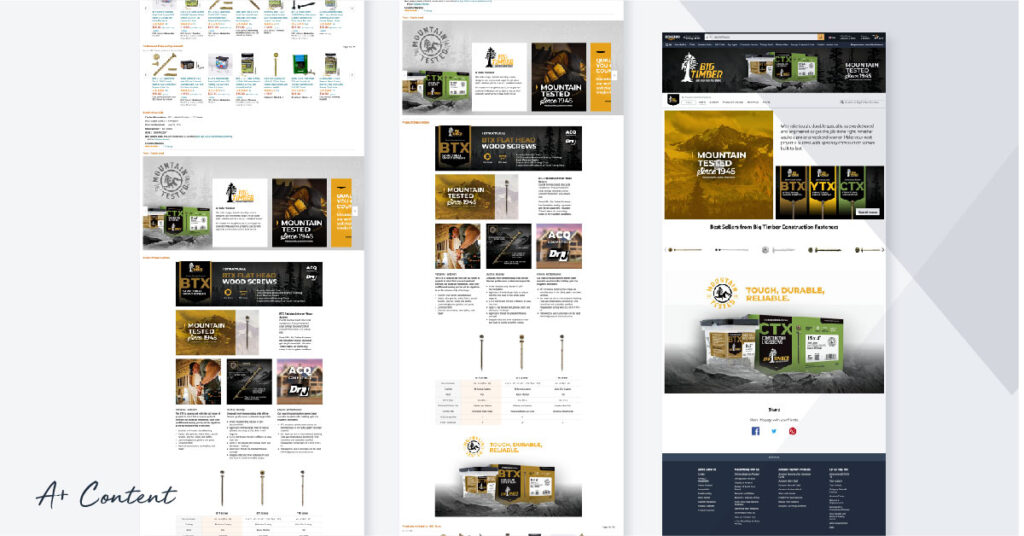5 Keys to Amazon Listing Optimization
Rob Seas Content Strategist & Copywriter
Following Amazon SEO best practices is critical to selling successfully on the world’s largest online sales platform. Set up your Amazon storefront properly from the start and you’ll kick off a virtuous cycle where higher search rankings lead to increased sales, which further boost your search rankings.
The goals of Amazon product listing optimization are:
- Driving traffic to your product listings
- Increasing product and brand visibility
- Boosting conversion rates/sales growth
Much like Google, Amazon uses an algorithm (A9) to decide how products rank in search results. This algorithm first considers keywords to determine which results are most relevant to the search and therefore which it will display first. But since Amazon is a store with a vested interest in sales, A9 also evaluates the likelihood of a purchase by considering sales metrics such as click-through rate (CTR), conversion rate and total sales.
Thus, A9 pushes listings with a strong sales history and high conversion rate toward the top of the search results page. The one exception is new product listings, which don’t have to compete on sales metrics since that data doesn’t yet exist. Amazon sellers call it the “Honeymoon Period” and it’s generally believed to last about one month. Using this grace period wisely can make or break the success of your product listing by helping you get ahead of competitors in the virtuous cycle referenced above. That means having all aspects of the listing optimized before launch.
FIND THE RIGHT KEYWORDS
It’s estimated that 90 percent of Amazon searches start with the search box. It’s a sophisticated tool that online shoppers can use to locate products quickly in combination with the drop-down menu of departments. Search filters allow users to further refine the results.
To compile keywords to use throughout your product listing, start with the Amazon search box and put yourself in the customer’s shoes. Cast a wide net initially and refine the list as you go, looking closely at suggestions for related searches that appear in the drop down. Focus on both short- and long-tail keywords. Look at competing products and the keywords they’re using to refine your list.
While there are some unique features of Amazon search, you don’t need to reinvent the wheel and can use existing SEO tactics and strategy that apply to your business website. In addition, Amazon keyword research tools such as JungleScout’s Keyword Scout and ahref’s Keywords Explorer can provide granular search data that you can slice and dice in different ways to gain insights.
 SEED THE PRODUCT LISTING
SEED THE PRODUCT LISTING
Use every opportunity Amazon gives you to optimize your listings by placing your researched keywords in the following areas:
Product title: The product title is vital both for A9 search relevance and for customers. The sweet spot for length is 60-80 characters, which gives you the opportunity to include keywords and enough detail to entice a click. Best practices include:
- Matching the title on the physical packaging
- Use title case
- Include the brand name
- Use numerals versus spelling out numbers
- Avoid: symbols (e.g., © or ®); subjective wording (e.g., “Best Seller”)
Product description: The product description gives you another chance to expand on your keyword placement. Include them in details about product features and usage that help customers find, evaluate and purchase products. You can also highlight specific product information not located elsewhere in the listing.
Include the brand name as well as sizes, materials, colors, quantity, etc. Even though the brand name appears in the title and description, it’s important to add it in the “brand” field as well for inclusion in searches that filter for brand.
Product key features bullets: Amazon gives you five bullets to list key features “About this item.” Use all of them to briefly outline important criteria that will help shoppers decide to buy. Summarize your product’s most important features or advantages using 500 characters or less for each bullet. Use relevant keywords where they fit but don’t force them. Put the bullets in order of importance with the top feature listed first.
Image alt text: You can use the alt text field in images to highlight select keywords. Amazon gives you 100 characters to describe the image. Use spaces and provide a concise description without using superlatives. For example, if your product and primary keyword is a “bath towel set,” write an alt text that fully conveys what’s in the image like, “plush green and tan bath towel set.” Keep in mind that alt text is intended to make visual content available to the visually impaired or as a backup when an image doesn’t load properly. Write the short description without punctuation as a clear word picture of the image.
IMAGES SELL
In addition to the main “featured” image, Amazon allows seven additional images to depict your product and its features from various angles. Ideally, you want to upload eight images that depict a blend of product details, the product in use, and graphically designed photos that call out features, benefits and attributes of the product. Use lifestyle imagery where appropriate to create aspirational branding that helps customers imagine themselves using the product.
Make sure the featured image shows the product clearly on a white background. Other requirements and best practices include:
- Images must be at least 1,000 pixels (longest side) x 500 pixels (shortest side)
- The product must fill at least 85% of the image
- Images are required to have a minimum resolution of 72 dpi
- The maximum image size is 10,000 pixels (longest side) and 10 MB
- Use only JPEG, PNG, GIF, or TIFF files
- Use a product identifier (e.g., the Amazon ASIN, an ISBN or UPC number) in the file name
- Optimize the images and ensure they’re mobile-friendly for small screens
- As noted above, add alt text
 THE STORE (Enhanced Brand Optimization)
THE STORE (Enhanced Brand Optimization)
Vendors and sellers enrolled in Amazon’s Brand Registry have the ability to create a dedicated store page and options for A+ content on their product listings. Both give you additional real estate that has been shown to increase sales by double digits.
Since this article is mainly concerned with Amazon product listing optimization, we won’t go in depth on store pages, but they do offer a curated brand destination. They are linked from your product listings and can educate customers about your brand and show best-selling products and/or your entire portfolio. It’s an opportunity to showcase your brand and products in a space free of competitor ads. On your store page, customers only see your brand without the distractions found on product listing pages. You have more creative freedom to feature infographic and video content that helps close the sale.
A+ content does reside on your product listing page and replaces the product description. Similar to the store page, this feature allows you to use extra text and images on your product detail page to tell the story of your brand and product. It’s free to use but only available if you’re registered as a brand.
THE CLOSER: VIDEO
Video is also available to all brand-registered Amazon sellers. The right product video can increase conversions by over 80%. It’s one of the best possible ways to optimize your listing and offers an opportunity to truly engage potential customers. Think more in terms of an explainer video versus a TV ad. You want to highlight features and benefits and show the product in use without being overly “sales-y.” Dive deeper into what your product can do and how it works.
Videos give shoppers a lot of information quickly in a format that allows them to focus exclusively on your product without distraction. They can also have an emotional impact by including aspirational lifestyle aspects.
Your Amazon product listing strategy is an important element of your digital marketing strategy, but it should also work in concert with the overall marketing strategy for your brand and products. Done right, Amazon product listing optimization can become an important element in building a successful brand.
Need help optimizing your Amazon product listings? Kinetic can help you bring together all the elements needed for a powerful, cohesive brand message and selling presence on Amazon. Call us today!
Rob Seas
Content Strategist & Copywriter
Rob graduated from Syracuse University with a degree in Journalism, held a variety of editorial positions across the country and has worked as a freelance web developer for companies large and small, ranging from startups to international corporations like Visa, The Nature Conservancy, and Levi Strauss & Co. before joining Kinetic Marketing in 2021.
Read more about Rob



